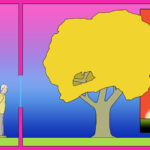“Dementia” is the term for a set of symptoms resulting from brain-damaging diseases such as Alzheimer’s and others. According to the National Institutes of Health (NIH), a primary symptom of dementia is “difficulty speaking, understanding and expressing thoughts.”
When people with dementia are in pain, they are likely to be unable to describe what type of pain they are experiencing, what hurts, or how it hurts. Research has found a high prevalence of pain in dementia. Further, researchers have found that, in dementia, pain is perceived and processed differently. According to a 2021 study by Bunk et al., for individuals with a dementia-related cognitive impairment, “pain processing seems to be heightened in dementia,” resulting in “amplified pain responses.”
Although other pain assessment scales are available, in assisted living facilities and among hospice providers, the primary measure of pain in dementia patients is the use of vital signs. According to Wikipedia, “There are four primary vital signs: body temperature, blood pressure, pulse (heart rate), and breathing rate (respiratory rate).”
Since dementia patients are unable to speak, treatment providers assume that elevated vital signs indicate the presence of distress or pain.
Science has reported for more than a decade that reliance on vital signs to assess pain is no less than cruelty.
I protest. On behalf of science and humanity, I protest.
Do no harm.
Excerpt from a 2007 interview with Catherine A. Marco, MD, FACEP, author of the 2006 study, Self-reported pain scores in the emergency department: lack of association with vital signs – my bold:
The study disproves a longstanding belief in emergency medicine: that pain is associated with abnormal vital signs, says Catherine A. Marco, MD, FACEP…”We have all heard people say, ‘I don’t believe that the patient is really in pain, because the vital signs are normal. If they were really in pain, they would be tachycardic or hypertensive,'” she says. “We showed that is not true, and that many patients in significant pain have normal vital signs.”
Indeed, Daust el al., in a 2015 report on a study of 153,567 patients, stated unequivocally – my bold: “Health care professionals cannot use vital signs to estimate or substantiate self-reported pain intensity levels or changes over time.”
In dementia caregiving, a false dichotomy is cited between “agitation” and “pain.” However, according to Kaufmann et al., in their 2021 study, Pain and Associated Neuropsychiatric Symptoms in Patients Suffering from Dementia: Challenges at Different Levels and Proposal of a Conceptual Framework – my bold: “There is accumulating evidence that in non-communicating patients with advanced dementia observable neuropsychiatric symptoms (e.g., depression, agitation, restlessness, writhing, vocalizations, etc.) should not only be considered as ‘pure’ psychiatric sequelae of neurodegeneration, but as manifestations of unrecognized pain.”
Excerpts from additional studies, listed in chronological order:
“A lack of any meaningful correlation between pain scores and changes in vital signs in this population [adult patients treated by paramedics] demonstrates that these signs cannot be used to validate the severity of pain reported by adult patients.”
– Lord et al., The reliability of vital signs in estimating pain severity among adult patients treated by paramedics, 2009
“Findings regarding the use of vital signs for pain assessment are not consistent and should be considered with caution. As recommended by experts, vital signs should only be used as a cue when behavioural indicators are no longer available in mechanically ventilated or unconscious patients.”
– Arbour et al., Are vital signs valid indicators for the assessment of pain in postoperative cardiac surgery ICU adults?, 2009
“Recent literature demonstrates that pain in patients with dementia is often undertreated…Subjective reports are the most valid approach for the assessment of the subjective experience of pain and should therefore be preferred over other methods.”
– Bornemann-Cimenti et al., Pain assessment in patients with dementia, 2012
“Given this lack of certainty, we believe that the morally most defensible position is to err on the side of relieving possible pain and suffering instead of erring on the side of not relieving pain and suffering. There is a great deal we do not know about human sensation, awareness and, nociception, the noxious sensation of pain as such, without regard to its emotional significance…Finally, failure properly to manage pain – to assess, treat, and manage it – is professional negligence.”
– Perkin and Resnick, 2002
“Nursing assistants’ perception of pain is based on ethical concerns and on their own subjective pain experiences rather than on medical skills.”
– Karlsson et al., Certified nursing assistants’ perception of pain in people with dementia: a hermeneutic enquiry in dementia care practice, 2013
“Individuals with neurological disorders such as dementia are susceptible patient groups in which pain is frequently under-recognised, underestimated, and undertreated…The systematic study of facial expressions through a computerised system has identified core features that are highly specific to the experience of pain.”
– Hadjistavropoulos et al., 2014, Pain assessment in elderly adults with dementia
“The commonly held (but incorrect) belief that people
with cognitive impairment feel and experience less pain
contributes to a significantly greater risk of underassessment and undertreatment of pain in people with dementia.”
– Molton et al., Overview of persistent pain in older adults, 2014
“Behavioural and psychological symptoms of dementia such as agitation and aggression often arise as a result of underlying pain.”
– Lichtner et al., Pain assessment for people with dementia: a systematic review of systematic reviews of pain assessment tools, 2014
“Family caregivers may help in the identification of pain-related behaviours and should be more involved in the ICU pain assessment process. Fluctuations in vital signs should only be considered as cues for further assessment of pain with appropriate tools, and may better represent adverse events of severe pain. Other physiologic measures of pain should be explored in the ICU, and pupillometry appears as a promising technique to further study.”
– Gelinas, Pain assessment in the critically ill adult: Recent evidence and new trends, 2016
“According to our study findings, vital signs are not strong indicators for pain assessment in neurosurgery ICU patients. However, HR and RR can be used as cues when behavioral indicators are not valid in these unconscious patients.”
– Erden et al., Vital signs: Valid indicators to assess pain in intensive care unit patients? An observational, descriptive study, 2018
“Aim: Develop and evaluate the implementation of a protocol for comprehensive management of pain in advanced dementia.”
– Montoro-Lorite et al., Integrated Management of Pain in Advanced Dementia, 2020
“In their last 12 months, nursing homes residents with dementia suffer most common from restrictions in mobility, pain, and sleeping disorder.”
– Eisenmann et al., Palliative Care in Advanced Dementia, 2020
“Pain is usually communicated verbally, a skill that is increasingly lost in people with dementia. As a result, those affected suffer unnecessarily from treatable but unrecognized pain.”
– Achterberg et al. Pain in dementia, 2021
“Thus, only respiratory rate showed clinically significant increases during nociceptive procedures. Correlations of VS [vital signs] with self-reported pain (the gold standard measure) and behavioural pain scores were absent or weak (r< 0.30) suggesting their lack of validity for ICU pain assessment. Conclusions: This updated review dissuades the use of VS [vital signs] for ICU pain assessment. Consistent with SCCM [Society of Critical Care Medicine] practice guidelines, VS [vital signs] should only be used as cues for initiating further pain assessment with validated tools.”
– Shariri et al., The validity of vital signs for pain assessment in critically ill adults, 2022
“Of the AUs [facial action units] present, AU7 (eyelid tightening) was the most frequent facial expression (48.6%) detected, followed by AU43 (closing eyes; 42.9%) and AU6 (cheek raising; 42.1%) during severe pain. AU20 (horizontal mouth stretch) was the most predictive facial action of higher pain scores. Eye-related AUs (AU6, AU7, AU43) and brow-related AUs (AU4) were more common than mouth-related AUs (e.g., AU20, AU25) during higher pain intensities. No significant effect was found for age or gender. These findings offer further understanding of facial expressions during clinical pain in PLWD and confirm the usefulness of artificial intelligence (AI)-enabled real-time analysis of the face as part of the assessment of pain in aged care clinical practice.”
– Atee et al., Faces of Pain in Dementia: Learnings From a Real-World Study Using a Technology-Enabled Pain Assessment Tool, 2022
On behalf of those with the symptoms of dementia, who suffer in anguish, wordlessly, unnecessarily, from treatable but unrecognized, unacknowledged pain, I protest.
All content on this site is for informational purposes only and is not a substitute for medical, professional, and/or legal advice. Consult a qualified professional for personalized medical, professional, and legal advice.


